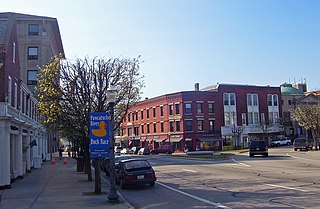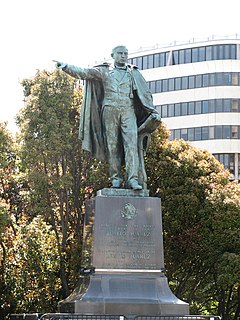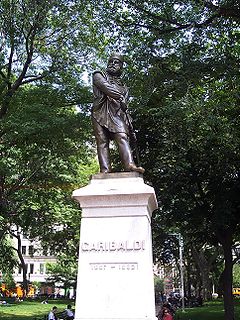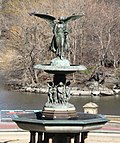| Alexander Hamilton | |
|---|---|
 | |
| Artist | Carl Conrads |
| Year | 1880 |
| Type | Sculpture |
| Medium | Westerly granite |
| Subject | Alexander Hamilton |
| Location | New York City, New York, United States |
| Coordinates: 40°46′51.7″N73°57′52.4″W / 40.781028°N 73.964556°W | |
Alexander Hamilton is an outdoor granite sculpture by Carl Conrads, located in Central Park, Manhattan. [1] Hamilton's son, John C. Hamilton, commissioned Conrads to sculpt this statue, which was dedicated on November 22, 1880, and donated to the city. [2] [3] Conrads used the bust of Hamilton created by the sculptor Giuseppe Ceracchi as a model for Hamilton's head. [4]
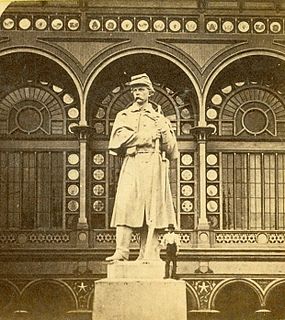
Carl H. Conrads was an American sculptor best known for his work on Civil War monuments and his two works in the National Statuary Hall Collection at the U.S. Capitol in Washington, D.C. He was also known as Charles Conrads.

Central Park is an urban park in Manhattan, New York City. It is located between the Upper West Side and Upper East Side, roughly bounded by Fifth Avenue on the east, Central Park West on the west, Central Park South on the south, and Central Park North on the north. Central Park is the most visited urban park in the United States, with 40 million visitors in 2013, and one of the most filmed locations in the world. In terms of area, Central Park is the fifth largest park in New York City, covering 843 acres (341 ha).

Manhattan, often referred to locally as the City, is the most densely populated of the five boroughs of New York City and its economic and administrative center, cultural identifier, and historical birthplace. The borough is coextensive with New York County, one of the original counties of the U.S. state of New York. The borough consists mostly of Manhattan Island, bounded by the Hudson, East, and Harlem rivers; several small adjacent islands; and Marble Hill, a small neighborhood now on the U.S. mainland, physically connected to the Bronx and separated from the rest of Manhattan by the Harlem River. Manhattan Island is divided into three informally bounded components, each aligned with the borough's long axis: Lower, Midtown, and Upper Manhattan.
Contents
American founding father Alexander Hamilton lived nearby in Manhattan, at Hamilton Grange, when he died in 1804. [2]

The Founding Fathers of the United States, or simply the Founding Fathers, were a group of philosophers, politicians, and writers who led the American Revolution against the Kingdom of Great Britain. Most were descendants of colonists settled in the Thirteen Colonies in North America.

Alexander Hamilton was an American statesman and one of the Founding Fathers of the United States. He was an influential interpreter and promoter of the U.S. Constitution, as well as the founder of the nation's financial system, the Federalist Party, the United States Coast Guard, and the New York Post newspaper. As the first Secretary of the Treasury, Hamilton was the main author of the economic policies of George Washington's administration. He took the lead in the Federal government's funding of the states' debts, as well as establishing a national bank, a system of tariffs, and friendly trade relations with Britain. His vision included a strong central government led by a vigorous executive branch, a strong commercial economy, a national bank and support for manufacturing, and a strong military. Thomas Jefferson was his leading opponent, arguing for agrarianism and smaller government.



